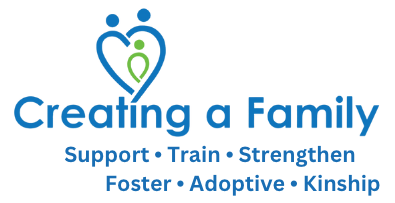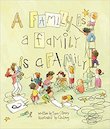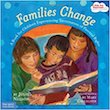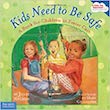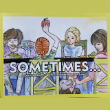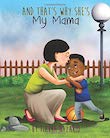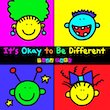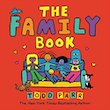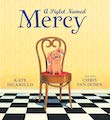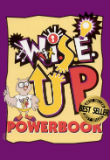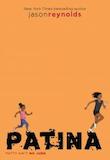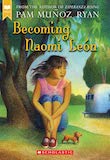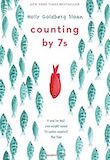Kinship Care General Books for Kids

A Grandfamily for Sullivan by Beth Winkler Tyson (ages 3-7) – Sullivan is a scared little koala who cannot understand why he is living with his grandmother now and why he cannot be with his mom and dad. When he goes to the park with his grandmother, he meets a new friend who helps him figure out a fun new way to handle all the big feelings he has inside about these big changes. This sweet and gentle story and the tools from Sullivan’s new friend will help your little one find healthy coping tools and learn to talk about what is troubling him.
A Family Is a Family Is a Family by Sara O’Leary (ages 4-7) – A heartwarming and whimsical story about accepting all types of family. The story starts with a kindergarten teacher asking her students to think about what makes their family special, a nerve-wracking assignment for a young girl in foster care who worries that her family is too different from her classmates. However, she soon learns that all her classmates’ families are different. One is raised by a grandmother, and another has two dads. One is full of step-siblings, and another has a new baby. As her classmates describe who they live with and who loves them, the girl realizes that as long as her family is full of caring people, her family is special. A wonderful book to introduce children to families that look different from their own, and to reassure adopted and foster children that there’s nothing wrong with their family looking different from others.
Families Change: A Book for Children Experiencing Termination of Parental Rights (Kids Are Important series) by Julie Nelson (ages 4-7) – All families change over time. Sometimes a baby is born, or a grown-up gets married. And sometimes a child gets a new foster parent or a new adopted mom or dad. Children need to know that when this happens, it’s not their fault. They need to understand that they can remember and value their birth family and love their new family, too. Straightforward words and full-color illustrations offer hope and support for children facing or experiencing change. Includes resources and information for birth parents, foster parents, social workers, counselors, and teachers.
Kids Need to Be Safe: A Book for Children in Foster Care by Julie Nelson (ages 4-7) – Kids need safe places to live which, for some kids, means living with foster parents. In simple words and pictures, this book explains why some kids move to foster homes, what foster parents do and ways kids might feel during foster care. It also addresses the common fear that children are in foster care because of their bad behavior, making clear that the troubles in their lives are not their fault.
Sometimes… A Story of Transition For Foster and Adopted Children by Keri Vellis (ages 4-7) – Author Keri Vellis, a mother of six by birth and foster care adoption, wrote Sometimes… after she was unable to find age-appropriate books about foster care to read to her own children. Sometimes… follows the story of a timid foster child and a teddy bear as they learn about their new home. The book acknowledges that this transition can be frightening and is designed to help children understand and feel safe along their journey, all while providing comfort and acceptance into their new environment.
And That’s Why She’s My Mama by Tiarra Nazario (ages 2-7) – This charming story celebrates diversity not only in family appearance, but in family size. It lets kids know that moms are wonderful, no matter what they look like or who they are, because moms take care of you no matter what. It’s not specifically about adoption, but it is about nontraditional families, and includes families formed through adoption and foster care.
It’s Okay to Be Different by Todd Parr (ages 4-6) – Parr uses his signature artistic style to tell kids (and adults) that it’s okay to be different. He addresses physical differences, disabilities, race, different family types and uses a picture of a kangaroo with a dog in its pouch to tell kids it’s okay to be adopted. A good introduction to multiculturalism and diversity, whether or not it focuses on adoption.
The Family Book by Todd Parr (ages 3-6) – It’s become a classic for families with young children and falls into the all important “all families are different, but still a family” category. Whether you have two moms or two dads, a big family or a small family, a clean family or a messy one, Todd Parr assures young children that no matter what kind of family you have, every family is special in its own unique way. An excellent introduction to the many ways families can be created.

What I Do Know by Lori Schlecht (ages 4-8) – Almost poetic, the rhythm of this book and it’s “I do know” and “I don’t know” create a weaving tale of diverse families, how families are formed and the love between parents and children in all the different kinds of families out there. The illustrations lend to the rhythm and flow of the story line.
A Piglet Named Mercy by Kate DiCamillo (ages 3-7) – Mr. Watson and Mrs. Watson live ordinary lives. Sometimes their lives feel a bit too ordinary. Sometimes they wish something different would happen. And one day it does, when someone unpredictable finds her way to their front door. In a delightful origin story for the star of the classic Mercy Watson children’s series, this is a delightful look at how nontraditional families are created and bound together with love.
Stellaluna by Jenell Cannon (ages 2-8) – While out searching for food, fruit bat Stellaluna and her mother are attacked by a vicious owl. Stellaluna is separated from Mother Bat and taken in by a family of birds where she must put aside her bat habits to fit in with her new family. But one fateful flight when she is separated from her adoptive siblings, Stellaluna is reunited with her bat family and learns that even though we’re different, we’re very much the same. A classic children’s book, Stellaluna is delightful story about temporary family.

You’re All My Favorites by Sam McBratney (ages 2-5) – Three little bear cubs are worried that Mommy and Daddy Bear might not have enough love for all three of them, or that one cub will be loved more than the others. Every night at bedtime, Mommy and Daddy Bear reassure their cubs that they are the most loved, most cherished bears in the world. A sweet tender story of acknowledging feelings of worry and anxiety many siblings feel in a family. It could be very useful to open a conversation about adding a sibling by adoption, to reassure resident children that their parents will have room to love all the children.

A Grandfamily for Sullivan by Beth Winkler Tyson (ages 3-7) – Sullivan is a scared little koala who cannot understand why he is living with his grandmother now and why he cannot be with his mom and dad. When he goes to the park with his grandmother, he meets a new friend who helps him figure out a fun new way to handle all the big feelings he has inside about these big changes. This sweet and gentle story and the tools from Sullivan’s new friend will help your little one find healthy coping tools and learn to talk about what is troubling him.
A Family Is a Family Is a Family by Sara O’Leary (ages 4-7) – A heartwarming and whimsical story about accepting all types of family. The story starts with a kindergarten teacher asking her students to think about what makes their family special, a nerve-wracking assignment for a young girl in foster care who worries that her family is too different from her classmates. However, she soon learns that all her classmates’ families are different. One is raised by a grandmother, and another has two dads. One is full of step-siblings, and another has a new baby. As her classmates describe who they live with and who loves them, the girl realizes that as long as her family is full of caring people, her family is special. A wonderful book to introduce children to families that look different from their own, and to reassure adopted and foster children that there’s nothing wrong with their family looking different from others.
Families Change: A Book for Children Experiencing Termination of Parental Rights (Kids Are Important series) by Julie Nelson (ages 4-7) – All families change over time. Sometimes a baby is born, or a grown-up gets married. And sometimes a child gets a new foster parent or a new adopted mom or dad. Children need to know that when this happens, it’s not their fault. They need to understand that they can remember and value their birth family and love their new family, too. Straightforward words and full-color illustrations offer hope and support for children facing or experiencing change. Includes resources and information for birth parents, foster parents, social workers, counselors, and teachers.
Kids Need to Be Safe: A Book for Children in Foster Care by Julie Nelson (ages 4-7) – Kids need safe places to live which, for some kids, means living with foster parents. In simple words and pictures, this book explains why some kids move to foster homes, what foster parents do and ways kids might feel during foster care. It also addresses the common fear that children are in foster care because of their bad behavior, making clear that the troubles in their lives are not their fault.
Sometimes… A Story of Transition For Foster and Adopted Children by Keri Vellis (ages 4-7) – Author Keri Vellis, a mother of six by birth and foster care adoption, wrote Sometimes… after she was unable to find age-appropriate books about foster care to read to her own children. Sometimes… follows the story of a timid foster child and a teddy bear as they learn about their new home. The book acknowledges that this transition can be frightening and is designed to help children understand and feel safe along their journey, all while providing comfort and acceptance into their new environment.
W.I.S.E. Up! Powerbook (ages 6-16) – Created by the Center for Adoption Support and Education (CASE) in 2009, the W.I.S.E. Up Powerbook is designed to help adopted children and children in foster care learn how to confidently handle their story and answer questions from others on their own terms. The book presents realistic situations that adopted and foster kids are likely to encounter, and guides parents and kids through different approaches to answering. Organized around the acrostic W.I.S.E., kids learn that they can Walk away, reply that It’s private, choose to Share something, or Educate others.

Suddenly Siblings: Adventures in Fostering and Adoption by Gail and Molly Heaton (ages 5-12) – This workbook of 25 lessons will help you prepare your children for the impacts of adopting or fostering a new sibling. There are practical, easy-to-implement tools to help your kids overcome the challenges common to siblings of kids from traumatic backgrounds and at the same time, strengthen your parent-child connection. The topics include: preventing sibling overwhelm, getting help when feeling overwhelmed, reducing conflict, improving communication skills, and coping with the stress or anxiety they might feel. There is an activity with each mini-lesson so you can work through the book at your own pace.
Author, Cindy R. Lee, has 6 books in this series (ages 7-9), each teaching lessons to young kids about managing emotions, celebrating differences, and being part of a family, all using trauma-informed strategies of the TBRI™ model. The books include tips and support for parents.
And That’s Why She’s My Mama by Tiarra Nazario (ages 2-7) – This charming story celebrates diversity not only in family appearance, but in family size. It lets kids know that moms are wonderful, no matter what they look like or who they are, because moms take care of you no matter what. It’s not specifically about adoption, but it is about nontraditional families, and includes families formed through adoption and foster care.
It’s Okay to Be Different by Todd Parr (ages 4-6) – Parr uses his signature artistic style to tell kids (and adults) that it’s okay to be different. He addresses physical differences, disabilities, race, different family types and uses a picture of a kangaroo with a dog in its pouch to tell kids it’s okay to be adopted. A good introduction to multiculturalism and diversity, whether or not it focuses on adoption.
The Family Book by Todd Parr (ages 3-6) – It’s become a classic for families with young children and falls into the all important “all families are different, but still a family” category. Whether you have two moms or two dads, a big family or a small family, a clean family or a messy one, Todd Parr assures young children that no matter what kind of family you have, every family is special in its own unique way. An excellent introduction to the many ways families can be created.

What I Do Know by Lori Schlecht (ages 4-8) – Almost poetic, the rhythm of this book and it’s “I do know” and “I don’t know” create a weaving tale of diverse families, how families are formed and the love between parents and children in all the different kinds of families out there. The illustrations lend to the rhythm and flow of the story line.
A Piglet Named Mercy by Kate DiCamillo (ages 3-7) – Mr. Watson and Mrs. Watson live ordinary lives. Sometimes their lives feel a bit too ordinary. Sometimes they wish something different would happen. And one day it does, when someone unpredictable finds her way to their front door. In a delightful origin story for the star of the classic Mercy Watson children’s series, this is a delightful look at how nontraditional families are created and bound together with love.
Stellaluna by Jenell Cannon (ages 2-8) – While out searching for food, fruit bat Stellaluna and her mother are attacked by a vicious owl. Stellaluna is separated from Mother Bat and taken in by a family of birds where she must put aside her bat habits to fit in with her new family. But one fateful flight when she is separated from her adoptive siblings, Stellaluna is reunited with her bat family and learns that even though we’re different, we’re very much the same. A classic children’s book, Stellaluna is delightful story about temporary family.

You’re All My Favorites by Sam McBratney (ages 2-5) – Three little bear cubs are worried that Mommy and Daddy Bear might not have enough love for all three of them, or that one cub will be loved more than the others. Every night at bedtime, Mommy and Daddy Bear reassure their cubs that they are the most loved, most cherished bears in the world. A sweet tender story of acknowledging feelings of worry and anxiety many siblings feel in a family. It could be very useful to open a conversation about adding a sibling by adoption, to reassure resident children that their parents will have room to love all the children.
The Love Tree by Katie Biron (ages 3-8) — Family trees can be problematic for adoptees and kids in foster care. In response, author, illustrator, and adoptive and foster mom Katie Biron wrote “The Love Tree.” This charming book follows the story of Little Mouse, who comes home from school and tries to complete a difficult school assignment–creating a family tree. After a few tears of confusion and frustration, his adoptive mom, Mother Fox, explains that every family is different. Together, they create a “Love Tree,” including all those who love Little Mouse, such as birth parents, adoptive parents, siblings, and even neighbors. “The Love Tree” gives all kids a beautiful way to showcase their unique families proudly!
What Is Your Story? by Lynn Deiulis (ages 4-9) — This colorful children’s book is designed to help children discover their unique journey of adoption or kinship and to normalize their questions and their need to ask them. Divided by activity pages, each chapter can be read independently and even out of order in an effort to focus on each child’s specific story. The author, an adoptee, was united with the illustrator, her birth half-sister, as an adult. Their mutual understanding of the impact of adoption enriches this book. A good resource for adoptive and kinship caregivers, as well as professionals working with children who are living through adoption or kinship processes.
W.I.S.E. Up! Powerbook (ages 6-16) – Created by the Center for Adoption Support and Education (CASE) in 2009, the W.I.S.E. Up Powerbook is designed to help adopted children and children in foster care learn how to confidently handle their story and answer questions from others on their own terms. The book presents realistic situations that adopted and foster kids are likely to encounter, and guides parents and kids through different approaches to answering. Organized around the acrostic W.I.S.E., kids learn that they can Walk away, reply that It’s private, choose to Share something, or Educate others.

My Flight Training Manual: Flying Above the Clouds in Sibling Relationships by Gail Heaton (ages 10-14) – This workbook offers tweens and teens an opportunity to learn scientific research about how sibling relationships impact them. It reviews the common challenges siblings of kids from trauma histories will experience and offers tools for preventing the overwhelm they may feel from their siblings’ challenges. Parents can use this as a tool for also strengthening trust and communication between them when working on the book together. Practical information on how to reduce sibling conflict, how to work together on relationships, and how to ask for help when relationships struggle.

Suddenly Siblings: Adventures in Fostering and Adoption by Gail and Molly Heaton (ages 5-12) – This workbook of 25 lessons will help you prepare your children for the impacts of adopting or fostering a new sibling. There are practical, easy-to-implement tools to help your kids overcome the challenges common to siblings of kids from traumatic backgrounds and at the same time, strengthen your parent-child connection. The topics include: preventing sibling overwhelm, getting help when feeling overwhelmed, reducing conflict, improving communication skills, and coping with the stress or anxiety they might feel. There is an activity with each mini-lesson so you can work through the book at your own pace.

The Black Foster Youth Handbook: 50+ Lessons I Learned to Successfully Age-Out of Foster Care and Holistically Heal by Ángela Quijada-Banks (ages 8+) – This is a practical series of 50+ mini lessons written to help tweens and teens navigate the foster care system and heal beyond it. Foster youth have a wide variety of potentially supportive adults (foster/resource parents, case managers, GALs, therapists and social workers), and knowing where to look and garner care and support is key for the adolescent years. These professional support persons will also find this handbook helpful to support the young persons they serve.
Patina by Jason Reynolds (ages 10+) – Patina opens with two contrasting scenes. In the first, Patty misjudges her competitors in an 800-meter race she’s certain she should have won. She ran well, but placing second is not good enough for the ferociously competitive Patty. In the other scene, she braids her little sister’s hair before church, finishing off each of Maddy’s 30 braids with three beads. She does this every Sunday because their white adoptive mother can’t (“there ain’t no rule book for white people to know how to work with black hair”) and because their birth mother insists they look their best for church. Because their father has died and their birth mother lost her legs to diabetes, the two girls now live with their father’s brother and his wife. They see their mother once a week in an arrangement that’s as imperfect as it is loving and necessary. This is a compelling story that tackles adoption, kinship care, race and class, as well as grief at the loss of a parent and the struggle to fit in at a new school. Patina is the second book in Reynolds’s Track series, but the first to focus on adoption and works as a stand alone.
Becoming Naomi León by Pam Muñoz Ryan (ages 10-14) – Fifth-grader Naomi León Outlaw’s great-grandmother has been a loving guardian for Naomi and Owen, her handicapped brother, since their mother divorced their father and abandoned them in Lemon Tree, California seven years earlier. Life can be difficult, but Naomi feels safe in the regular routines of life until the unexpected arrival of her long-absent mother throws everything off balance. The troubled young woman’s difficulties threaten to overturn the security Gram has worked to provide for Naomi and Owen. With friends’ help, Gram takes the children to Oaxaca City to find their father and gain his support in her custody appeal. This is a beautiful story of connecting with and finding family and celebrates children who may live with a grandparent or other relative.
Counting by 7s by Holly Goldberg Sloan (ages 10-14) – A popular middle school choice, this is the story of 12-year old Willow who loves counting and diagnosing medical conditions. But when her adoptive parents die in a tragic accident, her life is turned upside down. Her new friend Mai Nguyen persuades her mother to take Willow in; despite the Nguyens’ poverty, their makeshift home and open arms help bring Willow back from the void. This heartwarming book about Willow’s life after the accident and then finding her new family and her place in the world is ultimately a celebration of the indomitable human spirit.
*As an Amazon Associate we earn from qualifying purchases, but we only recommend books that we value. Thanks for your support!
